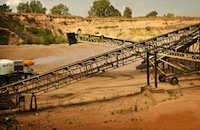
June 3, 2015 – Dust Control Technology has developed a versatile and transportable atomized mist unit, combining a workhorse electric dust suppression design with a 45 KW generator set.
In response to customer input from several different industries, Dust Control Technology (DCT) designed the DustBoss DB-60 FusionTM, which can be hauled to job sites that lack a convenient power source.
“Controlling air quality is essential for communities surrounding a construction or demolition project, but even in places with little infrastructure, dust can choke worksites and foul equipment,” said DCT president Laura Stiverson. “We engineered the Fusion to be highly mobile, with its own power source, able to be easily towed anywhere on a job site.”
The DB-60 Fusion forces water through a circular stainless steel manifold with 30 atomizing spray nozzles, then launches millions of tiny droplets with a powerful 25 HP fan that produces 30,000 CFM (849.50 CMM) of air flow. Atomized mist droplets of 50 to 200 microns in size are thrown out in a 200 foot (60 meter) cone at an adjustable 0 to 50° elevation angle, capturing airborne dust particles and dragging them to the ground. Unlike industrial sprinklers used for the same purpose, which can require 500 GPM (1893 LPM) or more of water, the DB-60 uses about 23 GPM (87 LPM) to help avoid pooling or runoff.
The unit is paired with a 45 KW gen set featuring a John Deere Tier III Flex engine featuring a 100-gallon fuel tank, allowing up to 24 hours of runtime. The diesel engine delivers 480 Volts (60 Hz) with a full load current of 46 amps. The Fusion also has a 120-volt outlet to provide jobsite power for any accessories or tools.
The DB-60 and gen set are mounted together on a heavy-duty trailer with a steel frame and roadworthy tires for towing at highway speeds. Weighing a total of 6,550 lbs. (2,971 kilos), it can be towed with virtually any vehicle with suitable towing capacity equipped with a Class IV ball hitch.
At just 80 inches (2.03 meters) wide, it can be placed virtually anywhere dust suppression is needed and adjusted based on changes in wind or work activity. The optional dosing pump is powered from the standard 120V electrical outlet on the gen set, allowing operators to precisely meter surfactants or other additives. The unit’s versatility makes it suitable for uneven ground, as well as open spaces or tiered terrain.
Water sources can vary, and the unit requires a constant supply pressure of just 10 PSI (.069 BAR). The water is delivered through a 1-1/2” (38.10 mm) hose with a cam-and-groove quick disconnect coupling leading to the booster pump. The pump adds approximately 150 PSI (10.34 BAR), with a maximum of 250 PSI (17.23 BAR), depending on the inlet pressure. For use with a non-potable water source, the Fusion is equipped with an in-line 30 mesh, 595-micron filter system.
A touch screen panel for controlling the dust suppression unit is encased in a NEMA 3R cabinet allows operators to control oscillation, booster pump, fan and water. The cabinet is constructed for outdoor use, designed to provide protection against ingress of solid foreign objects (such as dirt), air (dust, emissions), water (rain, sleet, snow) and ice formation.
In addition to the control panel for the DustBoss, the unit features an on/off function for the gen set located outside the generator itself. Full control and maintenance readings are located on a control panel inside, but operators do not need to access the interior to turn it on and off.
If potable water is being used, nozzles typically need to be inspected just once per year. The turntable bearing on the oscillator should be greased annually or as needed for harsh service conditions and the fan’s motor and high-pressure pump should be lubricated every 10,000 hours. Like any diesel engine, the gen set should have regular inspections and changing of oil, coolant and filters.
“Our customers are global and mobile, experiencing environments from jungle to tundra,” Stiverson concluded. “Our goal was to design a freestanding unit, which catered to those needs without compromising performance, with easy transport and adaptability to a wide range of conditions.”
Print this page
